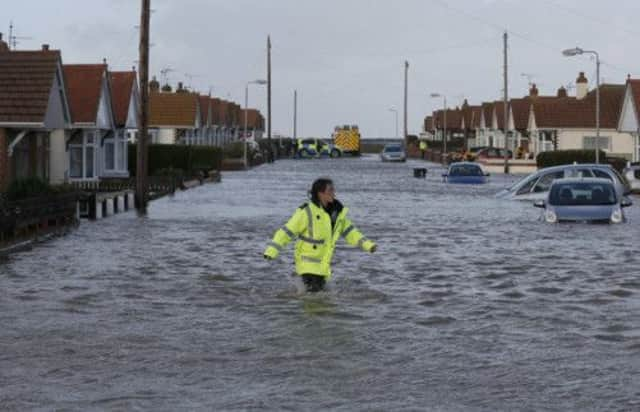Weather: Coastal communities fear 18ft storm surge


The River Tyne burst its banks after heavy rain, while lifeboats were sent to rescue people from their homes in Rhyl, North Wales.
A man died in Nottingham after a tree fell on him in a park, taking the death toll to two following the death of a lorry driver north of the Border.
Advertisement
Hide AdAdvertisement
Hide AdThe Environment Agency issued more than 250 flood alerts across England and Wales, including 34 severe flood warnings which are only issued when flooding poses a “significant threat to life”.
A lorry overturned and trapped a car in Newcastle-upon-Tyne, while thousands of homes in Cumbria and the north-east of England were without power last night.
The agency warned that communities along the North Sea coast from Northumberland to Kent, in addition to those on the Irish Sea coast from Cumbria to Cheshire, were at risk of surges of similar magnitude. Across the country, tens of thousands of properties were hit by power cuts as winds of up to 140mph battered power lines.
Officials in many areas were yesterday setting up emergency accommodation and handing out sandbags to help people protect their homes, police said.
In Humberside, police declared an emergency as they prepared for coastal surges last night, while households in Suffolk and Kent were also told to be on alert.
Matthew Philpott, from the Environment Agency, said: “There’s some nasty weather in the North Sea at the moment with gusts of gale-force north-westerly winds coupled with spring floods and a large tidal surge.
“They are all combining to give quite a risk of flooding.”
Storm surges begin when a rising area of low pressure takes pressure off the surface of the sea, allowing it to “bulge” upwards. The Met Office said that as the most severe weather subsided in terms of wind and rain, the risk of coastal flooding was set to increase.
“North Sea areas are particularly prone to storm surges because water flowing into the shallower, southern end cannot escape quickly through the narrow Dover Strait and the English Channel,” said a spokesman.
Advertisement
Hide AdAdvertisement
Hide Ad“When storm surges combine with high tides, especially spring tides, and large waves they can cause flooding along coasts.”
More than 10,000 homes in Norfolk, Suffolk and Essex were evacuated after officials warned that the lives of people in the region could be at risk from the worst coastal tidal surge since devastating floods of 1953.
On that occasion, 326 people in Britain died after a combination of a high spring tide and a severe European windstorm over the North Sea led to a water level of more than 5.6 metres (18ft) above sea level in some locations. The low-lying Netherlands was also badly hit.
However, flood defences built since then mean many parts of the country are now better protected, the Environment Agency said. The incident in 1953 sparked major studies on strengthening of coastal defences in both the UK and the Netherlands.
Yesterday afternoon, firefighters evacuated 2,500 homes in Jaywick, near Clacton-on-Sea, in Essex. Essex’s chief fire officer, David Johnson, said waves were expected to reach half a metre over the sea wall.
Wildlife wardens in Lincolnshire were yesterday preparing to protect seal pups from high tides after dozens died in a tidal surge two years ago.
The first surges were expected to hit the north Norfolk coast at about 8pm yesterday. Low-lying places such as Wells Quay, Blakeney and Salthouses were thought to be most at risk.
Mike Jones, chairman of the Local Government Association’s environment board, said: “Local authorities up and down the country are preparing to divert staff from their normal duties and have placed additional employees on standby to work with fire crews and other emergency services to get people help if they need it.
Advertisement
Hide AdAdvertisement
Hide Ad“Staff have been preparing for this since being notified by the Met Office and have been taking measures such as testing local defences, putting barriers in place to prevent the waters travelling inland and setting up local rest centres.
“Plans have also been put in place to ensure that older and more vulnerable people are not put at risk and can still access the council help they rely upon.”